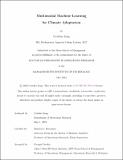| dc.description.abstract | Climate change stands as one of the most urgent challenges of our generation, with devastating floods in Pakistan, heartbreaking earthquakes in Turkey, and unprecedented wildfires in Canada. For over a century, meteorology has traditionally relied on solving dynamical equations, but machine learning (ML) is now emerging as a transformative force. This thesis explores how to use machine learning and optimization methods to address issues surrounding climate change adaptation and sustainable development.
The first part of the thesis focuses on developing multimodal machine learning frameworks for extreme weather forecasting. The multimodal ML approach integrates diverse sources and modalities of data, including text-based language, images, and tabular time series. The effectiveness of such an approach is showcased through two distinct case studies in extreme weather forecasting: in Chapter 2, a short-term hurricane forecast with a 12-hour lead time, and in Chapter 3, a long-term flood risk assessment model. Our contributions include the development of a generalizable multimodal ML framework to facilitate a wide range of prediction tasks in meteorology and beyond. Notably, our hurricane forecasting models demonstrate performance comparable to the National Hurricane Center’s top models for 24-hour intensity and track forecasts.
ML-driven weather forecasting models offer two distinct advantages over traditional dynamical models: significant reductions in computational time, enabling real-time, location-specific predictions, and the ability to develop long-term risk models for proactive disaster mitigation rather than reactive responses. Therefore, in the second part of the thesis, we delve into two application domains to envision the transformative force in addressing climate change-induced challenges. In Chapter 4, we introduce an Adaptive Robust Optimization (ARO) framework for designing insurance policies, combining historical and anticipatory risks obtained by machine learning models. In Chapter 5, we develop a real-time machine learning framework for wind forecasting, aimed at adjusting factory production levels to minimize air pollution and its impact on surrounding urban areas. In partnership with OCP Group, the world’s largest phosphate producer, our algorithm is now fully integrated into operational systems and reduces hazardous emission impact by 33-47% annually. | |
